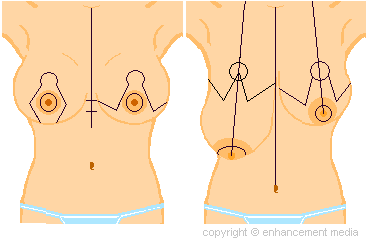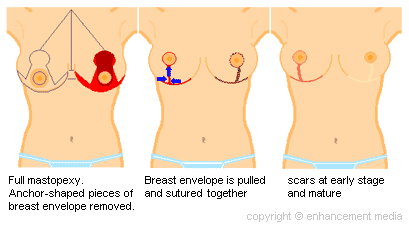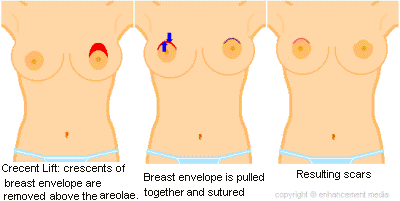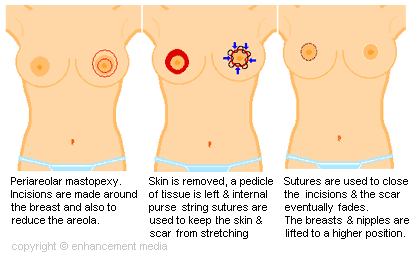How the Breast Lift Surgery is Performed
Breast lift surgery, or mastopexy, usually takes about 1 to 3 hours, depending on the technique used, the degree of ptosis (sag), whether implants are used to augment the breasts, the skill of the surgeon or the amount of correction needed. Your surgery may take longer if other procedures are being performed in conjunction with your breast lift, such as reduction or non-breast related procedures.
Breast Lift Surgical Markings
Your breasts will be marked up prior to breast lift surgery. These markings provide guidelines for your surgeon, indicating where the incisions for your breast lift procedure will be made and depicting the center of the sternum. He or she will use a Sharpie-type marker specifically made for surgery. Some surgeons draw your markings in the examination room, while others prefer to mark you up in the operating room.
There are many variations so the markings to the right may not be the same as the ones you get. The markings will remain on the skin after you are scrubbed with Betadine solution.

IV Insertion
You may be hooked up to the IV saline drip while being prepped you're your breast lift surgery and before going into the O.R. Other surgeons wheel you into the O.R. and insert your IV then. If you had been given an oral sedative or Valium ahead of time, you should be very relaxed and possibly barely aware of the IV procedure. If you haven't been given a sedative, the initial first few minutes until you are anesthetized may be stressful.
Having an IV inserted feels sort of like having blood drawn. The initial placement of the IV may sting a bit. Placement of the IV depends upon the quality of your veins. It's usually placed either in the crook of the elbow or the back of the hand.
After the needle is inserted into the vein, it is pulled out and a small tube is left in the vein. The tube is called a catheter. The catheter acts as an injection port and is taped to your skin to keep it secure. Medications can be introduced into the body via this port or be connected to the tubing to allow automatic infusion of drugs and intravenous fluids through a computerized drip system.
You may or may not receive some medications to help you relax or feel sleepy at this time. This can help with pre-operative anxiety if you were not given an oral medication to take ahead of time.
Monitoring Equipment
After you are placed on the operating table, the staff will hook you up to the heart monitoring and oximeter machines. Your vital signs will be monitored, including your blood pressure, body temperature, pulse rate/heart beat, and your breathing rate to determine if you are okay while under anesthesia. The staff will also check your blood pressure, and you will also have an oximeter clip (or strip) placed on your finger, earlobe, or big toe. The oximeter machine monitors the oxygen/carbon dioxide saturation in your blood.
You may also have intermittent pneumatic compression sleeves placed on your legs to decrease the risk of deep venous thrombosis (DVT) and subsequent pulmonary thromboembolism. Heavier patients may especially benefit from this. These devices are like inflatable sleeves for your legs and are either thigh or knee high. They inflate and deflate automatically to keep circulation optimal. You may also have heat lamps or heated blankets, depending upon the surgeon, your temperature, etc. Your vital signs must be stable before going any further.
Anesthesia Types Used in Breast Lift Surgery
If you and your plastic surgeon have chosen an IV liquid sedative, the anesthesiologist will manually insert medications with a hypodermic into a Y site or injection port along the length of the IV, attach a bag of anesthetic or use a computer-controlled drip system. The computer system automatically infuses a few drops of anesthetic every few seconds into a drip chamber where it mixes with the saline.
When the anesthesiologist releases the roller clamp on the IV line, the mixture starts flowing towards your body. The effects of the anesthesia are usually felt within a few seconds.
If you have chosen gaseous-state anesthesia (twilight, gaseous general), your mouth and nose will be covered with a mask and you will be told to count back from 100. You may remember getting only to about 96 before falling fast asleep. Then, the anesthesiologist will most likely intubate you, which involves inserting an endotracheal tube down your throat to deliver gaseous anesthesia to your lungs. However, some surgeons give you a little IV sedation and then intubate you and switch over to gaseous sedation.
Another option is with the use of a laryngeal mask airway (or LMA). This is a lot like the older intubation for general anesthesia, but there is a shorter tube and a little balloon the size of your two thumbs at he end. The tube holds your tongue down and of the way so it does not obstruct your breathing. The balloon inflates to block fluids from entering your windpipe (either saliva or stomach acid) and makes a seal so the gas can be delivered to your lungs. You may wake up with a raw throat with either, but it is usually less so with the LMA. The irritation or dryness is because cylinder air is d-r-y. There is no moisture in these tanks.
Regardless of the method, the gaseous anesthetic is mixed with oxygen and this is how you will breathe during your surgery.
Sterilizing the Surgical Field
The staff will scrub your torso (and other areas if you are having other procedures) with a surgical scrub. Then they'll rinse off the area with sterile gauze soaked in saline and paint your surgical area with an antiseptic. This will sterilize the area by killing surface bacteria, fungi, protozoa, viruses and yeasts. A common bacteria found on the skin is the naturally occurring Staphylococcus aureus, or staph, and this procedure decreases your risks of an infection.
Breast Lift Techniques
There are several breast lift techniques, and they are highly dependent on your needs as a patient and the surgeon's preference or training. They include the following:
-
Crescent Brest Lift
-
Benelli Lift (peri-areolar)
-
Benelli-Lollipop (keyhole)
-
Full Mastopexy (anchor)
The Crescent Lift: This technique involves removing a crescent-shaped piece of tissue above the areola and resuturing the tissue higher. This creates a minor lift for patients who have slight breast ptosis.
The Benelli Lift (concentric or periareolar or doughnut lift): This technique is considered less invasive and was designed with scars around the areolae. With the Benelli, a doughnut-shaped piece of tissue around the areola border is removed and the surrounding tissue sutured to the areola. The incisions are normally closed with purse string sutures. Sometimes a little more tissue is removed above the areola (as with the crescent lift) to compensate for a lifting effect when it is sutured. It results in a flatter, rounder breast shape post-operatively.
The Benelli-Lollipop (keyhole, vertical scar, Lejour): This lift is the same as the above but with straight incisions from under the areolae to the mammary folds (crease). This is for those who have medium ptosis, too much for the Benelli only and too little for a full anchor incision.
Full Mastopexy (anchor): The most commonly used mastopexy technique involves an anchor-shaped incision that starts at the base of the areola, vertically to the where the breast meets the rib cage. The incision then cuts out a crescent shape piece of skin right above where the breast meets the rib cage. Nipple repositioning is necessary with this technique as the nipple must be removed (see below). This is considered one of the major scarring techniques, but it is sometimes necessary with severely sagging breasts. With the standard Mastopexy, the incisions are made in the shape of an anchor at the natural crease of the breast up to the areola (darker skinned area) and nipple area.
Lift with an areolae reduction or relocation: This is sometimes needed to decrease the size of the areolae complexes. Sometimes you will get puckering with peri-areolar incisions, but this usually flattens with time, especially with the use of medical paper tape and/or silicone sheeting.
Of course, the actual incisions may be larger than the above diagrams depict, depending upon the level of ptosis. After the breast envelope is pulled together and sutured the incision line is a lot thinner, as depicted above. The scars may stretch due to tension, poor elasticity due to age or illness, implantation of very large breast prostheses or improper support during the healing phase. Scar tissue can take up to a year to mature.
Here is a diagram of an incision for a standard full (anchor) mastopexy with medium ptosis, the closure of the breast envelope/incision, suturing and the resulting thinner scar:

After the predetermined incisions are made, the excess skin is removed from the breast. The skin underneath the breast along the incision line is drawn together and sutured, lifting the breast to a new higher position. The areolae and nipples are removed (if applicable) and repositioned. The sutures will remain for about 10 days, depending upon the heaviness of the breast and if implants were added for augmentation.
 With the lollipop (or keyhole) mastopexy, the incisions are around the areolae and nipple area and in a straight line down from underneath the areola to the natural crease of the breast. It is like the standard mastopexy, but a little less tissue (in the shape of a triangle) is removed along with excess tissue around the areolae. This technique is generally used for breasts with a medium amount of ptosis. The incision edges are drawn together as in the standard mastopexy and sutured. The nipple and areolae complex is moved up as well.
With the lollipop (or keyhole) mastopexy, the incisions are around the areolae and nipple area and in a straight line down from underneath the areola to the natural crease of the breast. It is like the standard mastopexy, but a little less tissue (in the shape of a triangle) is removed along with excess tissue around the areolae. This technique is generally used for breasts with a medium amount of ptosis. The incision edges are drawn together as in the standard mastopexy and sutured. The nipple and areolae complex is moved up as well.
Again, if you have minimal ptosis, you can possibly qualify for a concentric (Benelli, peri-areolar, doughnut) mastopexy. If you have very minimal sag, the crescent lift may be enough for you. The anchor lift is the surgeon's most commonly chosen game plan if you have severe sag, although some surgeons do perform the Benelli with or without the addition of permanent sutures and report great results in very ptotic patients. Here is a diagram of an incision for a crescent mastopexy with little to medium ptosis, the closure of the breast envelope/incision, suturing and the resulting thinner scar:


If you are having breast augmentation with implants along with your mastopexy, please read our Breast Lift With Augmentation section, in its entirety.
After your surgery is finished, your sutures will be fully closed and you will be dressed in your bra or two and whatever type of compression/surgical garment your doctor likes. You are then gently woken up.
Coming Out of Anesthesia
The transition period can be rough for some patients. You may experience sickness, dizziness, crying, depression, anxiety, or haziness. It is generally like drinking a lot of alcohol and feeling drunk but with even less control over your body's movements at first. You may also be cold and shaking from the anesthesia. This will pass. Your throat may be sore if you have had general anesthesia via intubation.
You will be taken to the recovery room and placed in a recliner, hospital bed or gurney. You'll be lying somewhat upright to help with swelling and drainage. Your saline drip will more than likely still be in and you will usually still be hooked up to the monitors so that your recovery can be properly tracked. If you feel nauseous or are in pain, alert the recovery nurse. He or she will give you a pain reliever and possibly some antinausea medication or a few sips of cool water to settle your stomach.
If you chose light sleep sedation or a local with IV, you should be allowed to go home within 2 to 3 hours. If you chose general anesthesia, they'll want to keep you around for a bit longer. You may need to urinate directly after surgery due to the amount of saline in your system. In fact, your surgeon may insist that you do so before releasing you.
The Drive Home
You must have someone to drive you home and care for you for the first 48 hours after surgery. This person will need to help you to the bathroom, dressing, eating, etc.
